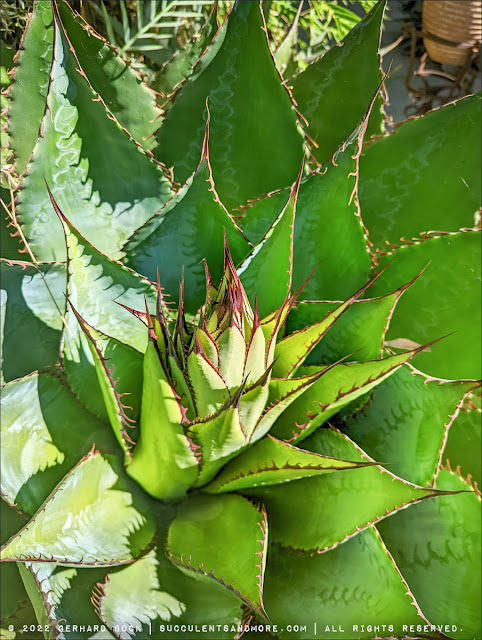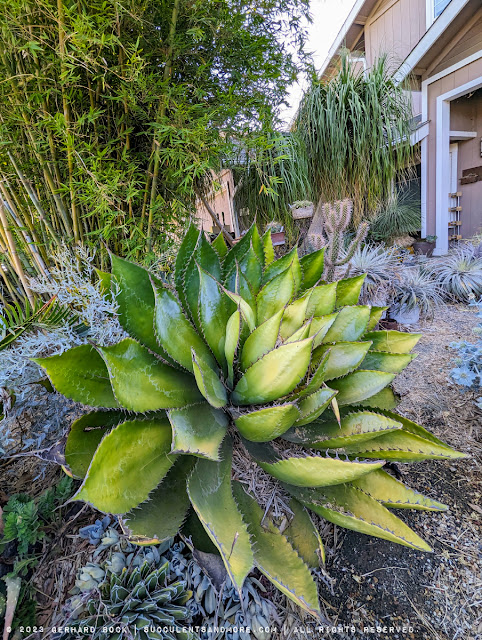RIP, cow horn agave (2015-2023)
Last September, the cow horn agave (Agave bovicornuta) in the front yard started to send up a flower stalk:
 |
| September 4, 2022 |
It took until May for the flowers to fully open. This is what the flower stalk looked like on June 23, 2023 (excuse the poor quality; these photos were taken through a window screen):
 |
| June 23, 2023 |
As you can see, the flower stalk had a precarious lean to it. I had visions of it toppling over, crushing everything in its path.
On June 28, 2023, my wife and I took down the flower stalk. It was heavy, and I had a hard time holding it steady as my wife sliced through it with a reciprocating saw. Here it is in the driveway, all 12 ft. of it:
 |
| 12 ft. flower stalk in the driveway |
 |
| Rosette right after we cut down the flower stalk |
Like most agave species, Agave bovicornuta is monocarpic, i.e., it dies after flowering. In the weeks after we’d removed the flower stalk, the rosette was losing more and more of its color as it was shutting down:
The lower leaves began to desiccate at an increasingly rapid pace, and I knew it was time to say our final goodbyes:
Here is the last photo I took of the rosette, just before I removed it last Saturday. It measured 4½ ft. in width and 4 ft. in height:
 |
| July 29, 2023, 8:48 a.m. |
I set my phone on a tripod and filmed the removal in time lapse. The video is only 18 seconds, but it took a bit longer in reality – about 30 minutes from start to finish, including dumping the leaves and the core into the yard waste bin.
Since Agave bovicornuta is a solitary species, there were no offsets.
Here’s the “after” photo:
 |
| Agave bovicornuta ’Holstein’ |
I scored a ‘Holstein’ from San Marcos Growers a few years ago. It's been sitting in a pot in the backyard all this time, not very happy but alive. Because of the record rainfall last winter, some leaves developed fungal spots, but the new leaves look pristine:
The San Marcos Growers web site gives a width of 4-5 ft. and a height of 2½ to 3 ft., so pretty close to the mature dimensions of our all-green bovicornuta. I’ll plant the replacement a bit further back so it won’t encroach into the path like the old one did.
I’m not in a hurry because I want to give myself plenty of time to change my mind a time or two. It’s much easier to go through different scenarios in your head rather than act them out in real life.
© Gerhard Bock, 2023. All rights reserved. To receive all new posts by email, please subscribe here.





If only we could actually take an agave down in 18 seconds! My Agave vilmoriniana came down this weekend too. My husband tied a rope around its 12 foot stalk and I held it tight to ensure it fell in the right direction while he sawed the stalk off. Now I only have to dig out its base...Planting an agave is a commitment so it's smart to give yourself time to deliberate but the variegated bovicornuta is a handsome plant..
ReplyDeleteDigging out an agave carcass: I find it easiest to cut off the leaves first and then dig out the rest.
DeleteA beautiful species. 'Holstein' is as well. You must have a lot of options to plant, so it will be interesting to see what you choose.
ReplyDeleteI have a few bloomed out Agaves that need to come out, but they'll have to wait until it cools off. 54 days to autumn!
Yeah, if I had more room, I wouldn't have been in a hurry to remove our bovicornuta.
DeleteLooks like you broke out the trusty Root Slayer and the recip saw-I have both so I feel better about my pending Blue Glow removal. I vote yes on 'Holstein' , it would look splendid there.
ReplyDeleteRoot Slayer + reciprocating saw (aka Sawzall) = unbeatable combination
DeleteSurprised at the size of cow horn agave as it didn't look that large in the photos. I can imagine it was quite a job getting it out. However, move over and let Holstein in. Has my vote for a replacement.
ReplyDeleteIt's often hard to convey size. I was surprised it was 4 x 4.5 ft, but that's what the measuring tape said.
DeleteIt didn't look as large in the photos - until the after photo of all the new open space! Love the video, such a good idea to film the removal. The Holstein is striking.
ReplyDeleteI'm trying to film more videos, esp. when a video says more than 100 photos :-)
DeleteI have such fond memories of that agave, it was a beauty—it even made it into the pages of my book. I look forward to seeing Holstein there in the future ;)
ReplyDeleteThis is my favorite agave ever. I'll miss it.
DeleteFingers crossed 'Holstein' will like this space. You never know with variegated plants, they can be fussy.
Great job! I love 'Holstein' as well. It will be pretty big there even with all the room but so special. I would do it! I know you used the reciprocating saw but I need to look up the "Root Slayer."
ReplyDeleteThis is the Root Slayer model I have: https://amzn.to/3DKcjtr. It's my favorite tool EVER for removing plants.
DeletePls continue to post videos from your garden. I still haven’t told you how fantastic I thought the recent filmed garden tour was; your garden is equal to, or surpasses, other gardens you’ve filmed. I had no idea, and the photos don’t convey such scale. Thanks for sharing.
ReplyDeleteThat's great feedback, thank you!
DeleteAgaves are so beautiful, and that species especially. Sounds like 'Holstein' would be a good pick for the next one. I always think it's sad that they die after flowering, but that's the way it is. :(
ReplyDeleteI had to take out a couple of large agaves too, this spring, the cold temps got one, and the other was leaning into plants that I'd rather have than the agave. I cut the leaves off with an orchard hand saw, during which I debated whether a sawzall would be worth buying, just for jobs like this. After watching you use it, I think I am going to spring for one after all. Like many people, I'm reactive to agave sap, breaking out into itchy blisters similar to poison oak exposure. Hopefully the electric saw would help limit exposure to the sap. Sue
ReplyDelete